Small dogs face digestive challenges that can make mealtime stressful for both pups and their families. Their tiny stomachs and fast metabolisms mean digestive upset can escalate quickly.
Prevention and early intervention matter a lot for small dog health and happiness.
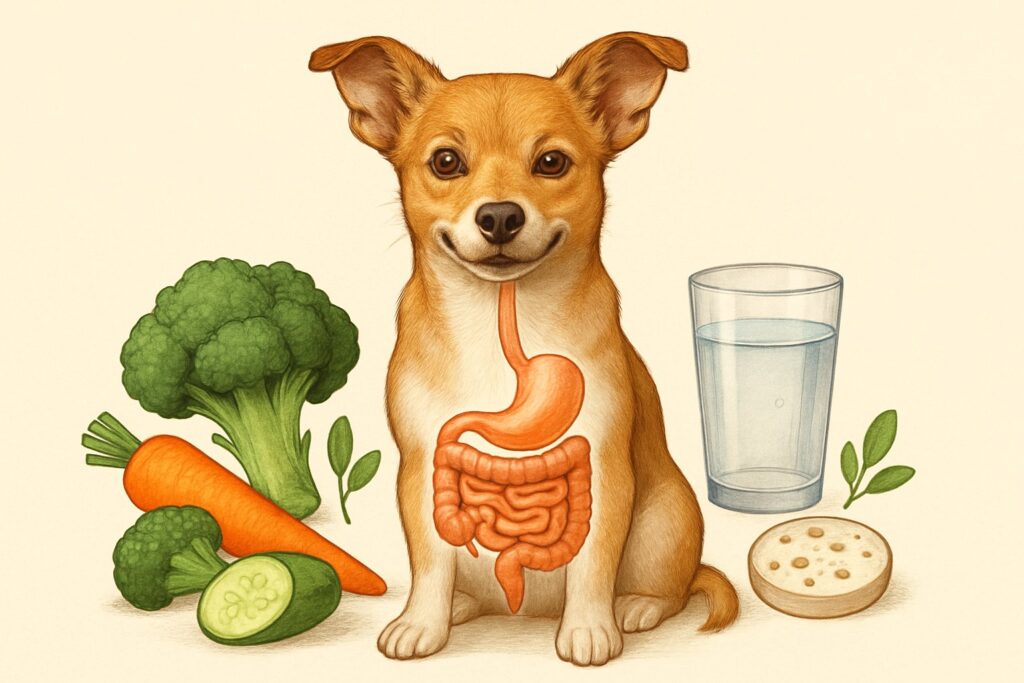
Table of Contents
Small dogs are more prone to digestive issues than larger breeds because their smaller digestive systems process food differently and react more sensitively to dietary changes. A Chihuahua’s stomach is about the size of a walnut, while a Great Dane’s stomach can hold gallons of food.
This size difference means small dogs need special attention when it comes to what they eat and how often. Even subtle signs that something’s off deserve a closer look.
From recognizing early warning signs to knowing which foods actually work for tiny tummies, small dog digestive health needs a tailored approach. Their unique needs can’t be ignored if you want to keep them comfortable.
Small Dog Digestive Health – Key Takeaways
- Small dogs have more sensitive digestive systems that require specialized diets and feeding schedules
- Early recognition of digestive symptoms like vomiting or diarrhea prevents serious health complications
- Simple lifestyle changes and proper nutrition can dramatically improve digestive health in small breeds
Understanding Small Dog Digestion
Small dog digestive systems work faster and more intensely than those of bigger breeds. These tiny digestive tracts process food in unique ways and make little pups more prone to stomach upsets.
How Small Breeds Digest Food
Small dogs have incredibly fast metabolisms that burn through calories like tiny furnaces. Their food moves through the digestive system in just 4-6 hours.
Larger breeds take 8-10 hours to digest a meal. The stomach-to-body ratio in small dogs is actually smaller than in big dogs.
This means less storage space for food. A Chihuahua’s stomach might literally be walnut-sized when empty.
High surface area in their intestines helps these little guys absorb nutrients quickly. It’s like having more checkout lanes at a busy store—food gets processed faster.
Small breeds need to eat more frequently because their stomachs empty so quickly. Three to four small meals work better than one or two big ones.
Their digestive enzymes work overtime to break down food rapidly. This intense process can sometimes lead to gas or loose stools if the food’s too rich.
Common Digestive Differences in Little Dogs
Hypoglycemia hits small dogs harder. Their fast metabolism burns through blood sugar quickly, so missing just one meal can cause dangerous drops in glucose levels.
Sensitive stomachs show up more often in toy breeds. Their compact digestive systems react strongly to sudden diet changes or rich foods.
Small dogs often experience reverse peristalsis—basically, food moving backward in their intestines. This causes more frequent vomiting than you’d see in larger breeds.
Dental issues affect digestion, too. Small dogs often have crowded teeth, so they don’t chew as well, and larger food pieces hit their stomach, making digestion harder.
Stress affects their digestion more intensely. A small dog’s nervous system is closely connected to their gut, so anxiety often shows up as stomach problems.
Why Stomach Sensitivity Happens
Concentrated stomach acid in small breeds can irritate the stomach lining easily. Their stomachs produce proportionally more acid for their size.
Limited gut bacteria diversity makes small dogs more vulnerable to digestive upset. Their shorter intestines have less space for good bacteria colonies.
Rapid gastric emptying doesn’t give food much time to break down. Partially digested food hits the small intestine too quickly.
Higher stress hormone levels in small breeds directly impact digestion. Cortisol and adrenaline slow down normal digestive processes.
Genetic factors play a role, too. Many toy breeds were bred for size, not digestive efficiency, so they inherited some sensitivities.
Signs of Digestive Issues in Small Dogs
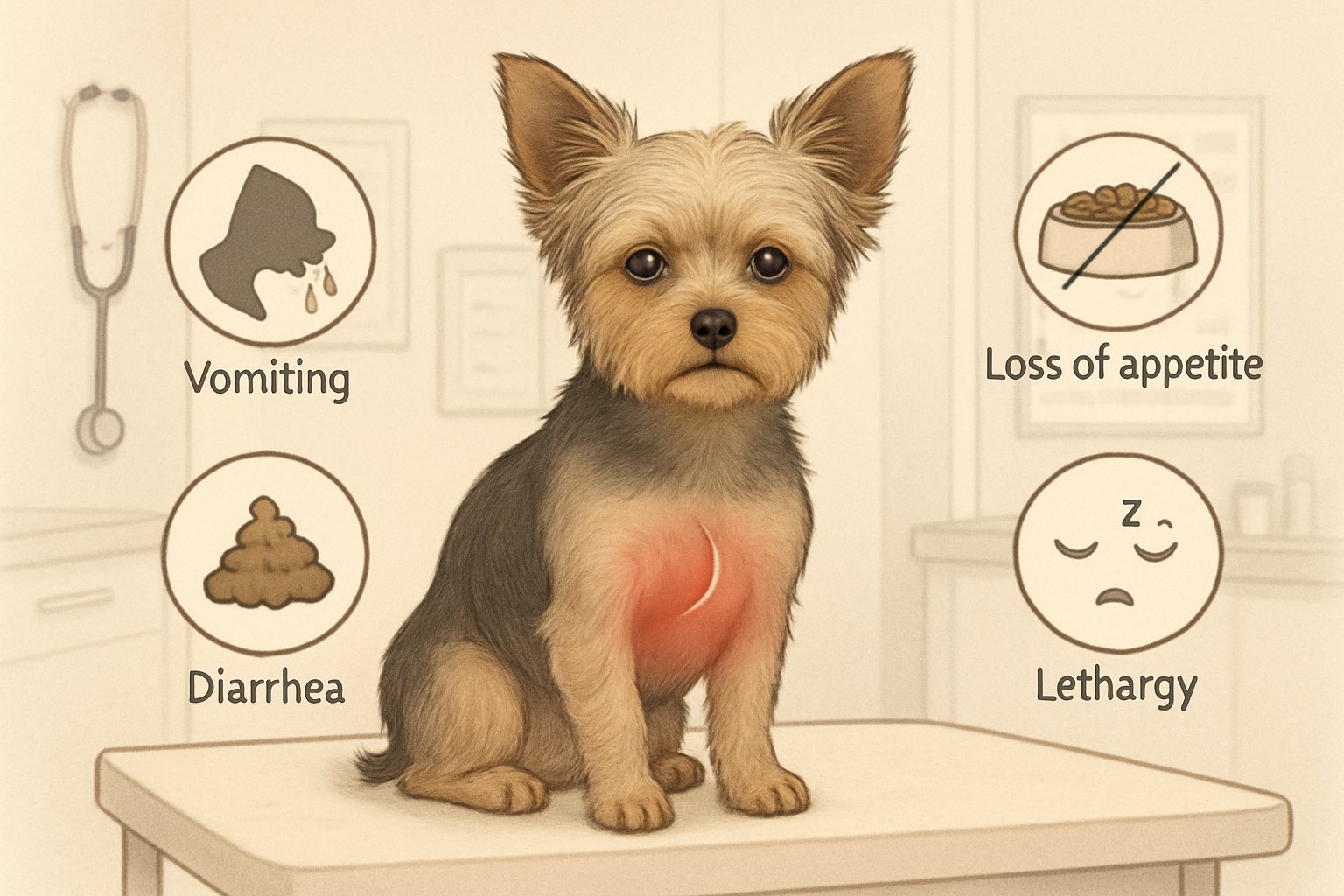
Small dogs often hide their discomfort until digestive problems get serious. Learning to spot early warning signs can save your tiny companion from unnecessary pain.
Spotting Mild Upsets
Small dogs can’t tell you when their stomach feels off, but their bodies give plenty of clues. Loss of appetite is often the first red flag.
If a food-loving Chihuahua suddenly turns away from dinner, something’s brewing in their belly. Mild vomiting once or twice might just mean they ate too fast.
Small dogs often gulp their food like it’s disappearing tomorrow. Changes in bathroom habits speak volumes, too.
Slightly softer stools or taking longer to go can signal the start of digestive trouble. Watch for excessive drooling during non-meal times.
Small dogs don’t usually drool much, so sudden slobber often means nausea. Restlessness at night might indicate stomach discomfort.
Dogs can’t pop an antacid like we do. These mild signs usually resolve within a day with basic care like fasting and bland food.
When Tummy Trouble Gets Serious
Some digestive problems need immediate attention before they snowball. Repeated vomiting more than three times in a day depletes small dogs quickly.
Their tiny bodies can’t handle fluid loss like larger breeds. Bloody or black stools never qualify as normal.
This means there’s bleeding somewhere in the digestive tract and your vet needs to see them. Severe gas with visible bloating creates real discomfort.
Small dogs’ compact bodies make trapped gas especially painful. Mucus in stools suggests intestinal inflammation.
The digestive lining is sending distress signals that shouldn’t be ignored. Lethargy combined with appetite loss lasting more than 24 hours means the problem isn’t resolving naturally.
Straining without results during bathroom breaks could mean blockage or severe constipation. That one calls for a professional.
Red Flags You Should Never Ignore
Certain symptoms demand immediate emergency veterinary care for small dogs. Projectile vomiting or dry heaving without producing anything suggests possible intestinal blockage.
Small dogs love eating things they shouldn’t, and their narrow digestive passages get blocked easily. Severe abdominal pain shows up as whimpering, hunched posture, or snapping when touched.
Dogs rarely fake pain signals. Complete loss of bowel control or inability to defecate for over 48 hours creates dangerous toxin buildup.
Pale or white gums indicate serious dehydration or internal bleeding. Press their gums and watch how quickly color returns.
Weakness or collapse means their body systems are shutting down. Small dogs deteriorate faster than large breeds during digestive crises.
Fever over 103°F combined with digestive symptoms suggests serious infection. Antibiotics and supportive care might be needed.
Never wait for multiple severe symptoms to appear. One major red flag means you should get professional evaluation right away.
Key Ingredients for Gut Health
The right ingredients can transform your small dog’s digestive health. Probiotics, prebiotics, and quality proteins work together like a three-part harmony for your pup’s belly.
Probiotics and Prebiotics for Pups
Ever wonder why your tiny terrier’s tummy seems more sensitive than larger breeds? Small dogs process food faster, so their gut balance is more delicate.
Probiotics are the good bacteria that keep digestive systems running smoothly. Think of them as tiny helpers working 24/7 in your dog’s intestines.
Best probiotic sources for small dogs:
- Plain Greek yogurt (no sugar or artificial sweeteners)
- Kefir in small amounts
- Fermented vegetables like sauerkraut
- Probiotic supplements designed for dogs
Prebiotics feed those good bacteria. They’re like fertilizer for a healthy gut garden.
Small breeds need gentler prebiotic sources because their systems are more sensitive. Sweet potatoes, pumpkin, and bananas work wonderfully.
The key is starting slow. A teaspoon of plain yogurt mixed into food can work wonders for a 10-pound pup.
Fiber Facts for Small Breeds
Small dogs need fiber, but not too much. Their tiny stomachs can’t handle the same fiber loads as bigger breeds.
Perfect fiber sources include:
- Cooked pumpkin (not pie filling)
- Sweet potato
- Green beans
- Carrots
- Apple slices (no seeds)
Here’s what many pet parents get wrong: they think more fiber equals better digestion. For small breeds, that’s backwards thinking.
A Chihuahua needs about 2-4% fiber in their diet. Too much causes gas, bloating, and loose stools.
Quick fiber guide by weight:
- 5-10 lbs: 1 teaspoon pumpkin daily
- 11-20 lbs: 1-2 teaspoons pumpkin daily
- 21-30 lbs: 1 tablespoon pumpkin daily
Watch your pup’s response. Solid, well-formed stools mean you’ve hit the sweet spot.
Best Protein Choices
Small dogs burn through energy fast. They need high-quality, easily digestible proteins that don’t sap their energy just to break down.
Their little bodies really can’t handle tough, low-grade ingredients.
Top protein picks for sensitive small dog stomachs:
- Boiled chicken breast (skinless)
- Turkey
- White fish like cod
- Eggs (cooked)
- Lean ground beef
Proteins to avoid:
- Fatty cuts of meat
- Processed meats
- Raw proteins (small dogs are more prone to bacterial infections)
Small breeds need about 25-30% protein in their diet. That’s usually higher than what you’ll find in a lot of commercial foods.
Bone broth made from these proteins can add some extra gut-healing benefits. Collagen helps repair the intestinal lining and delivers gentle nutrition.
Keep it simple when cooking proteins. Skip the seasonings, oils, and spices—those can upset delicate tummies.
Tailored Diets for Tiny Stomachs
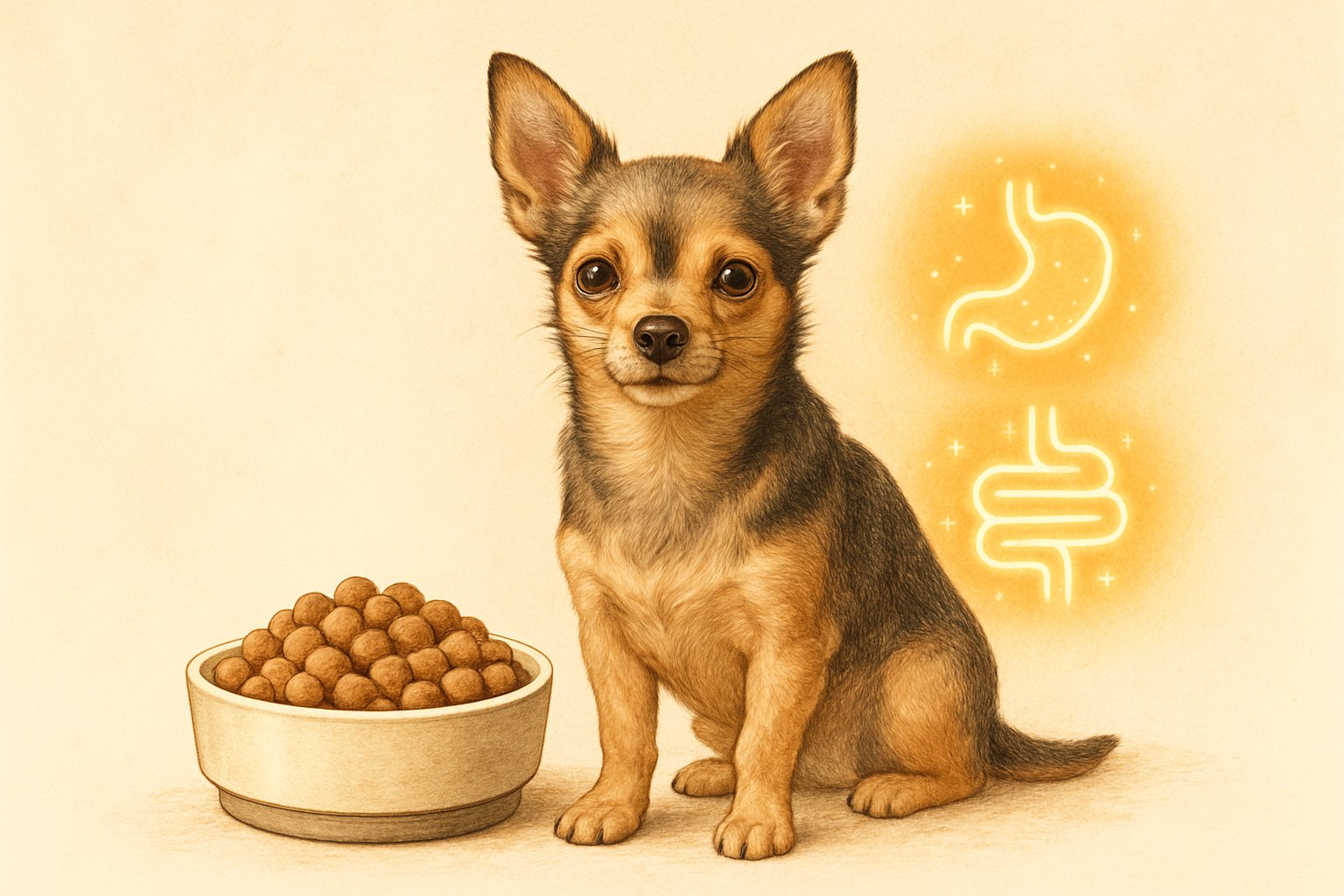
Small dogs need food that actually works with their tiny digestive systems. The right diet can really help prevent stomach upset and keep pint-sized pups feeling good.
Choosing the Right Kibble or Wet Food
Shopping for tiny dog food can feel overwhelming. Every bag claims to be a miracle, right?
But small breed formulas aren’t just marketing fluff—they’re actually built differently.
Look for kibble pieces smaller than a dime. Big chunks make little dogs work too hard to chew, which leads to gulping and stomach problems.
Wet food often works better for sensitive stomachs. It’s easier to digest and packs more water. Sort of like how soup feels better than crackers when you’re sick.
Key ingredients that help tiny stomachs:
- Prebiotics and probiotics for gut health
- Rice or sweet potato as gentle carbs
- Single protein sources like chicken or lamb
- No corn, wheat, or soy
Brands like Royal Canin and Purina make recipes just for small dogs with sensitive stomachs. They actually test their food on real dogs, not just in a lab.
Check the first three ingredients on any bag. You want to see real meat, not mystery meals or fillers.
Homemade Diet Dos and Don’ts
Making food at home sounds perfect for picky eaters. But tiny dogs have big nutritional needs that are surprisingly easy to miss.
The good news: Home cooking lets you control every ingredient. No weird preservatives or mystery meat.
The reality check: Most homemade diets miss important vitamins and minerals. Small dogs need precise nutrition or they can get sick quickly.
Safe homemade additions include:
- Plain cooked chicken or turkey
- White rice for upset stomachs
- Pumpkin puree (not pie filling)
- Boiled sweet potatoes
Never feed these to small dogs:
- Onions, garlic, or grapes
- Chocolate or artificial sweeteners
- Raw meat or eggs
- High-fat foods like bacon
Work with a vet before switching to homemade meals completely. They can help you build balanced recipes that won’t cause deficiencies.
Hypoallergenic & Limited Ingredient Meals
Food allergies hit small dogs harder than bigger breeds. Their tiny bodies react faster and stronger to problem ingredients.
Limited ingredient diets use just 3-5 main components. This makes it easier to spot what’s causing trouble.
Common allergens for small dogs include chicken, beef, dairy, and wheat. Novel proteins like duck, venison, or fish tend to work better for sensitive pups.
Top hypoallergenic options:
- Hill’s z/d for severe allergies
- Blue Buffalo Basics limited ingredient
- Wellness Simple with single proteins
Switching foods takes patience. Start with 25% new food and 75% old for three days, then go 50/50 for another three days. Move to 75% new food before switching completely.
Food trials last 8-12 weeks minimum. That’s how long it really takes to see results in small dogs with allergies.
Everyday Habits That Support Digestion
Simple daily routines can make a huge difference in how small dogs process food. The right feeding schedule, hydration, and smart portion control all work together to keep tiny tummies happy.
Feeding Schedules that Work Wonders
Small dogs have fast metabolisms and burn through food quickly. Their stomachs empty out faster than bigger breeds, so regular meals are crucial for steady digestion.
The magic number is three meals per day for most small dogs under 20 pounds. This keeps their blood sugar from dropping too low between meals.
Breakfast, lunch, and dinner help keep energy stable and reduce stomach acid buildup.
Timing matters as much as frequency. Dogs thrive on routine, so feeding at the same times daily helps their digestive system prepare for food.
Many owners have luck with these times:
- Morning: 7:00 AM
- Midday: 12:00 PM
- Evening: 5:30 PM
Free feeding doesn’t work well for small breeds. Leaving food out all day can cause overeating or picky eating, and it makes spotting digestive problems harder.
Puppies under six months need four small meals spread out through the day. Their tiny stomachs can’t hold much, and they need steady fuel for all that growing.
Hydration Habits for Happy Bellies
Water is essential for breaking down food and moving it through the digestive tract. Small dogs dehydrate faster than big ones, especially in hot weather or after exercise.
Fresh water should always be available, but where you put the bowl matters. Place it in a quiet spot where your dog feels safe drinking.
Some shy pups won’t drink if the bowl sits in a busy area—they’re funny that way.
The general rule is one ounce of water per pound of body weight daily. So a 10-pound Yorkie needs about 10 ounces of water a day.
Active dogs or those eating dry kibble might need even more.
Signs of good hydration include:
- Pink, moist gums
- Clear or light yellow urine
- Skin that snaps back quickly when gently pinched
Wet food helps boost water intake naturally. Dogs eating only dry kibble need to drink more, so tossing in a splash of low-sodium broth can help picky drinkers.
Portion Sizes and Treat Smarts
Small dogs need small portions, but it’s easy to overfeed by accident. Just a few extra kibbles add up fast—it’s like giving a kid another slice of pizza.
Follow feeding guidelines on dog food packages, but tweak them for your dog’s activity level and body shape. An active Jack Russell needs more than a couch-loving Pug, even if they weigh the same.
Use a measuring cup instead of eyeballing it. What looks like a tiny scoop might be too much for a 5-pound Chihuahua.
Digital kitchen scales are best for measuring those tiny portions.
Treats should make up no more than 10% of daily calories. For a small dog eating 400 calories per day, that’s just 40 calories in treats. Some training treats hit 15-20 calories each—yikes.
Break bigger treats into smaller pieces. Small dogs get just as excited for a crumb as for a whole treat, and it’s much easier on their stomachs.
High-value treats work better than lots of treats. Freeze-dried meat or a sliver of cooked chicken motivates small dogs without overloading their systems.
When to Call the Vet
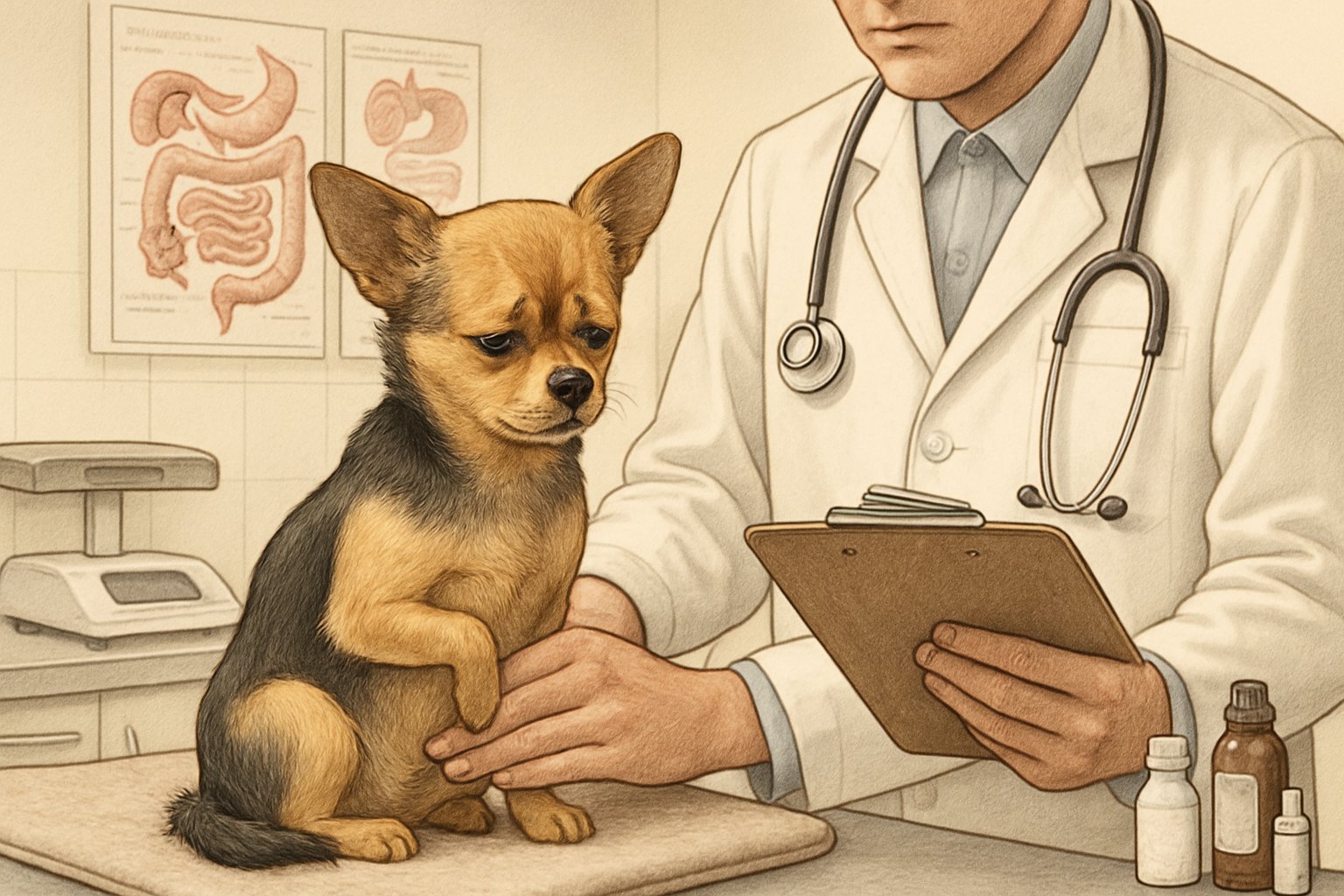
It’s tough to know when your small dog’s tummy troubles need a vet, but it can be the difference between a quick fix and a real emergency. Blood in vomit, repeated episodes in a single day, or signs of severe dehydration are all red flags—don’t wait on those.
Symptoms That Need Expert Eyes
Vomiting more than twice in 24 hours means something’s up. Small dogs dehydrate way faster than big ones, so time really matters.
Blood in vomit or stool is always an emergency. If it’s bright red, it’s fresh. Black, tarry stool means bleeding higher up in the gut.
Foamy or white vomit could mean bloat—a life-threatening problem. If you see that along with a swollen belly, get help now.
If your pup hasn’t pooped in 48 hours, that’s constipation and needs a vet. Small dogs should go at least once a day.
Watch for these danger signs:
- Lethargy plus digestive issues
- Fever (hot nose, panting, shivering)
- Severe dehydration (skin doesn’t snap back when pinched)
- Abdominal pain (hunched posture, whimpering when touched)
Diarrhea that lasts more than 48 hours needs a vet’s eye. If it’s watery and frequent, especially with vomiting, dehydration can set in fast.
What to Expect at the Clinic
Your vet will ask about symptoms, timing, and any diet changes. If you can, bring a fresh stool sample—it helps a lot.
Physical examination comes next. The vet checks hydration, temperature, and feels the belly for pain or swelling.
You might need blood work to check for infections or organ issues. Sometimes they’ll do X-rays to rule out blockages or bloat.
Treatment depends on what they find. Mild cases might just need prescription food and probiotics. Severe dehydration means IV fluids.
Emergency visits cost more than regular ones. You could pay anywhere from $200 to $800, depending on what tests are needed.
The vet might prescribe:
- Anti-nausea meds
- Bland diet instructions
- Probiotics for gut health
- Follow-up appointment scheduling
Don’t leave without clear instructions on feeding, meds, and what warning signs to watch for at home.
The Role of Stress in Digestive Health
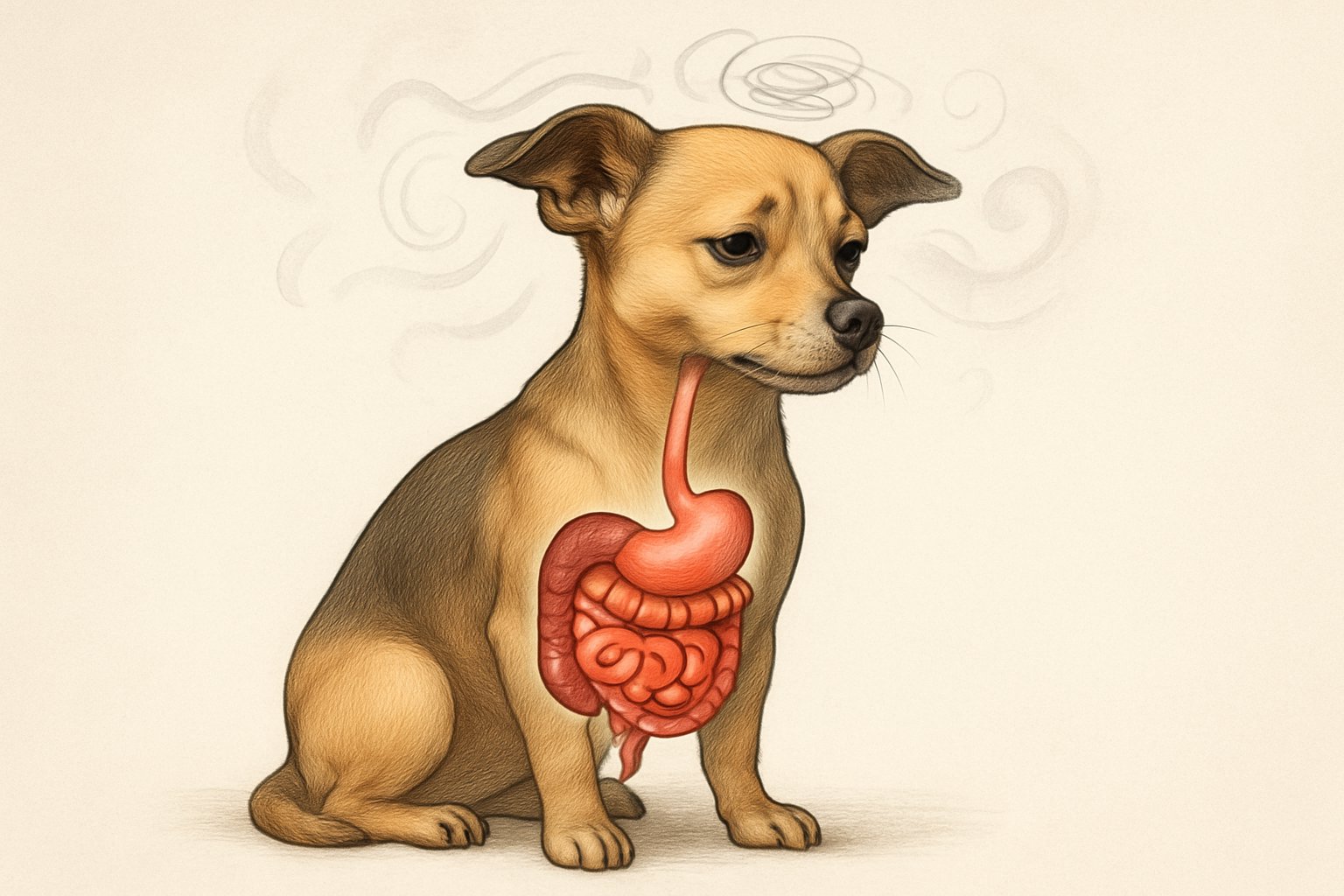
Stress doesn’t just make small dogs anxious. It can actually shut down their digestive system and kick off a rough cycle where gut issues ramp up anxiety even more.
The upside? Calming techniques can break this pattern and help their tummies get back on track.
How Anxiety Impacts the Belly
Ever notice how a stressed-out pup suddenly gets diarrhea or stops eating? That’s their body hitting the panic button, plain and simple.
When small dogs get anxious, their bodies pump out stress hormones. These chemicals basically tell the digestive system to shut down operations.
Why does this happen? In survival mode, digesting food just isn’t a priority—the body wants to deal with the threat first.
This leads to some real problems. The gut stops moving food along like it should, which can cause:
- Diarrhea or constipation
- Loss of appetite
- Nutrient absorption issues
- Stomach upset and nausea
Stress also messes with the good bacteria in a dog’s gut. These tiny helpers usually produce feel-good brain chemicals like serotonin.
When stress wipes out these beneficial microbes, the dog produces less serotonin. Less serotonin leads to more anxiety, which just circles back to more digestive problems.
Tips for Calming Nervous Tummies
Breaking the stress-digestion cycle means calming the mind and healing the gut. It’s not always easy, but it does work.
Create a stress-free eating environment:
- Feed meals in a quiet, safe space
- Use puzzle feeders to make mealtime engaging
- Keep feeding times consistent
- Remove other pets during meals if there’s competition
Support gut health directly:
- Add probiotics to restore good bacteria
- Try easily digestible foods during stressful periods
- Offer small, frequent meals instead of big ones
Address the anxiety itself:
- Use calming aids like pheromone diffusers
- Create safe spaces with cozy beds and blankets
- Practice gentle massage to reduce tension
- Try calming supplements with your vet’s approval
Environmental changes matter too. Remove obvious stressors when you can. If construction noise freaks out your dog, move them to a quieter room during the chaos.
Some folks swear by calming music made for dogs. Others use anxiety wraps that apply gentle pressure—kind of like a hug.
Stick with calming routines for at least 2-3 weeks. It takes time to see real improvements in both stress and digestive health.
Supplements and Safe Remedies
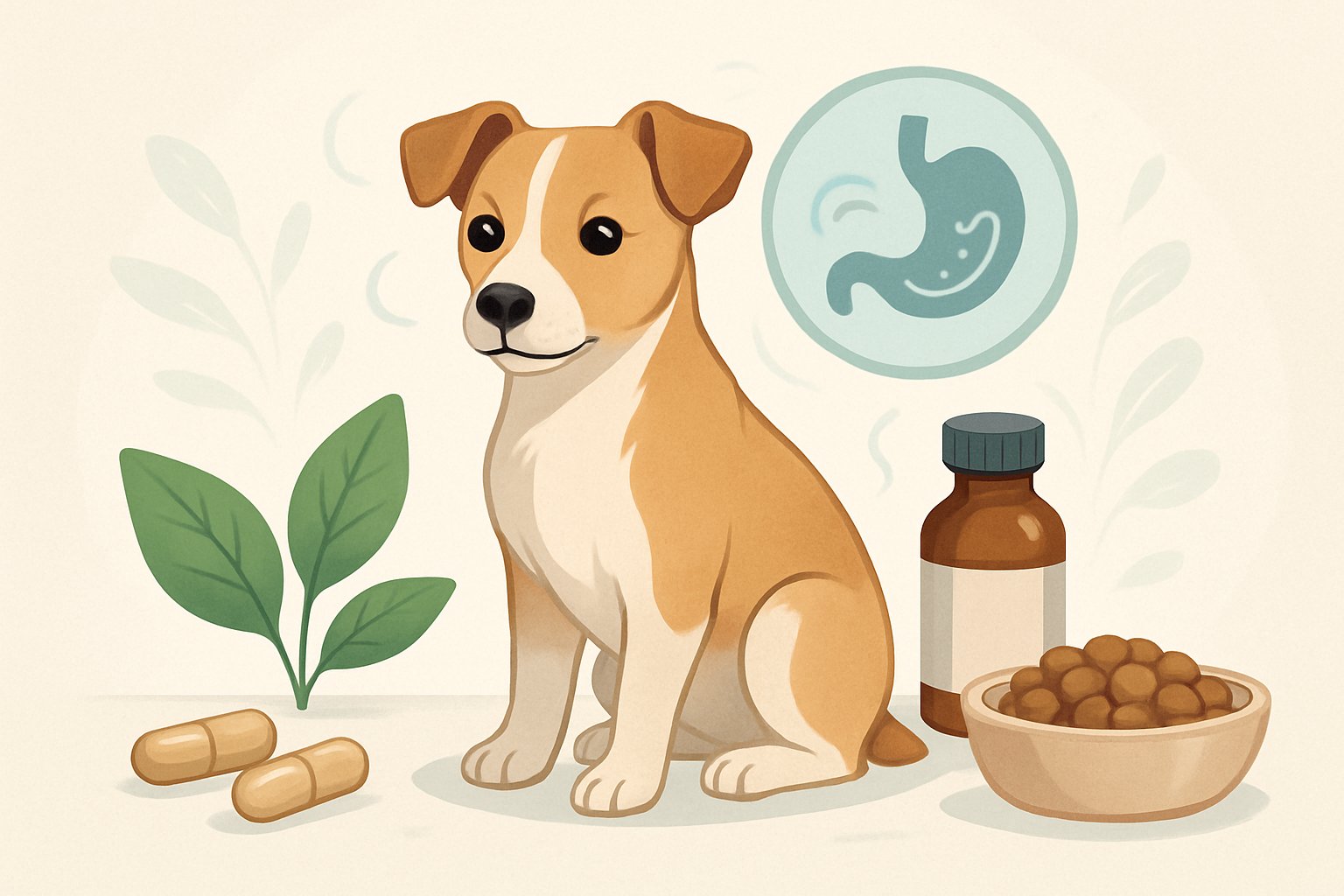
The right supplements can really change a small dog’s digestive health. But dangerous ingredients lurk on store shelves, so knowing what to pick (and what to skip) matters a lot.
Vet-approved digestive aids offer targeted relief for tiny tummies, but picking the wrong product can lead to trouble.
Top Vet-Recommended Picks
Probiotics top every veterinarian’s list for good reason. These beneficial bacteria restore gut balance after stomach upsets or antibiotic treatments.
Small dogs need 5-10 billion CFU daily. That’s much less than what big dogs require.
Digestive enzymes work like tiny helpers. They break down food when a dog’s pancreas can’t keep up, which helps prevent gas, bloating, and loose stools.
Pumpkin puree is nature’s gentle remedy. Just a teaspoon adds fiber that helps firm up runny stools. Make sure to use plain pumpkin, not pie filling with added spices.
Bone broth gives easy nutrition for sensitive stomachs. The collagen soothes inflamed intestines, and the electrolytes help prevent dehydration during digestive episodes.
Prebiotic fiber feeds the good bacteria already in the gut. Sweet potato, plain oats, and prebiotic powders all work well.
What to Avoid in the Supplement Aisle
Artificial colors and flavors spell trouble for sensitive small dogs. Additives like Red dye #40 can trigger allergic reactions and make inflammation worse.
Xylitol shows up in sugar-free digestive chews. This sweetener causes dangerous blood sugar drops in dogs—even tiny amounts can be deadly.
High-dose probiotics made for humans overwhelm small dog systems. Products with over 50 billion CFU can cause diarrhea instead of helping.
Dairy-based supplements bring problems for most dogs. About 90% of adult dogs can’t handle lactose, so milk-based probiotics usually backfire.
Herbal blends without dosage guidelines can be risky. Ingredients like garlic, onion powder, or high-dose herbs may damage red blood cells in small breeds. Always pick products with clear, species-specific dosing instructions.
Adapting as Your Dog Ages
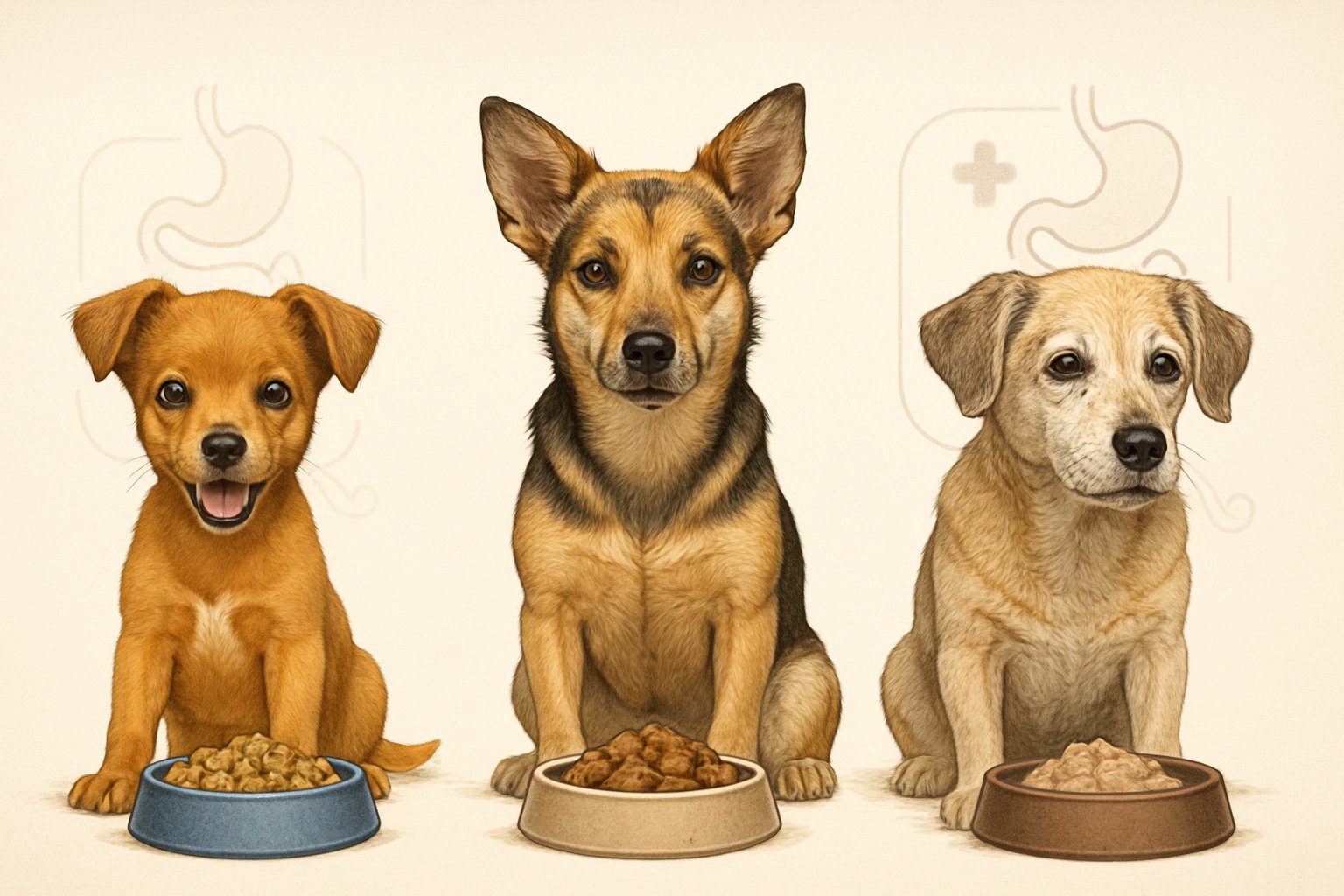
As small dogs get older, their digestive systems slow down and need different care. Senior pups benefit from more fiber and easier-to-digest proteins to stay comfortable.
Digestive Needs for Senior Small Dogs
Small dogs hit their senior years around 7-10 years old, depending on the breed. Their metabolism slows down during this time, and digestion gets a bit sluggish.
Food sits longer in their stomach and intestines, which can cause discomfort or even constipation. Their gut bacteria changes too—the good microbes aren’t as active, so nutrients don’t get absorbed as well.
Senior small dogs need more fiber in their diet. Carrots, sweet potatoes, or pumpkin help keep things moving.
Smaller, frequent meals work better than big portions. Try feeding three small meals instead of two large ones.
Watch for signs of digestive trouble:
- Taking longer to finish meals
- More gas than usual
- Hard or infrequent bowel movements
- Vomiting after eating
Adjusting Diets for Lifelong Wellness
Switching to senior dog food isn’t just about age. It’s about giving their changing body what it needs.
Higher fiber content is usually the first change. Senior formulas often have 3-5% fiber, while regular food has 2-3%. That extra fiber helps with bowel regularity.
Easier proteins make digestion smoother. Fish and chicken are gentler than beef or lamb. Some dogs do better with limited ingredient diets.
Make food transitions slowly over 7-10 days. Senior dogs are more sensitive to sudden changes, so mix the new food in gradually.
Prebiotics and probiotics can restore healthy gut bacteria. Look for foods with added beneficial microorganisms—they support the immune system too.
Consider these senior-friendly additions:
- Bone broth for extra hydration
- Digestive enzymes to help break down food
- Omega-3 fatty acids for inflammation control
Keep an eye on their weight. Senior dogs gain weight easily but have a hard time losing it. Adjust portions based on activity, not just appetite.
Real Stories: Pet Parents Share Digestive Wins
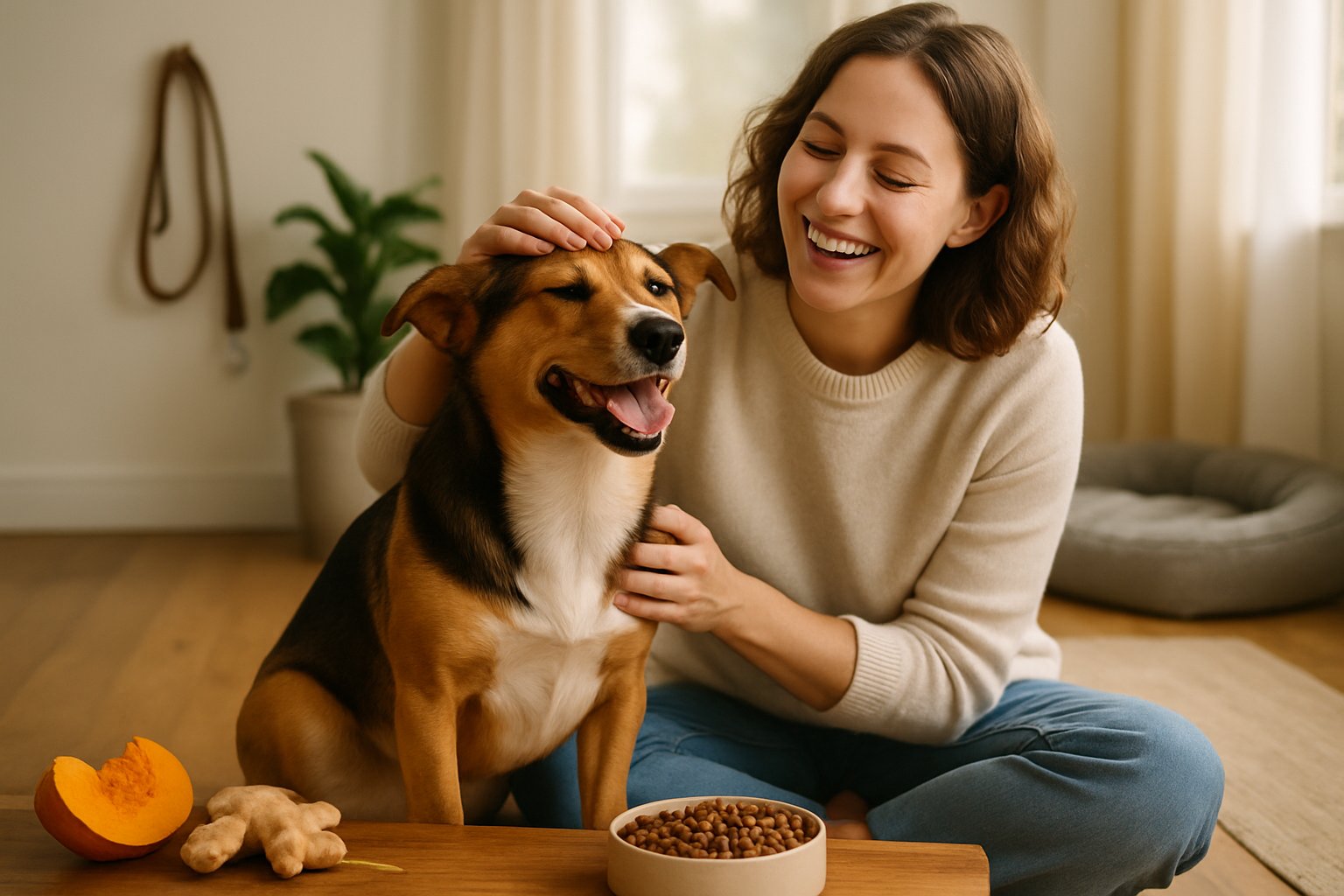
Sarah watched her Chihuahua Max struggle with loose stools for weeks. After switching to a bland diet of boiled chicken and rice, his digestive issues cleared up in just five days.
The Simple Food Switch Success
Many small dog owners get relief with basic dietary changes. Lisa’s Yorkie had chronic stomach upset until she cut beef out of his diet completely.
“I never thought it could be that easy,” Lisa said. Now her pup enjoys meals without the post-dinner discomfort.
Probiotic Power Stories
Tom started giving his French Bulldog daily probiotics after frequent digestive flare-ups. Within two weeks, her energy improved and bathroom trips became regular.
Tom also noticed his dog’s coat became shinier. Small breed dogs often show big improvements with gut support.
Meal Timing Magic
Jenny split her Pomeranian’s daily food into three smaller portions instead of two large meals. The change stopped his morning vomiting episodes.
- Patience during diet transitions (7-10 days minimum)
- Keeping food diaries to track triggers
- Working with vets for persistent problems
- Avoiding table scraps completely
Most pet parents saw improvements within 1-2 weeks of making changes. Real results take time, but small adjustments often lead to big digestive wins for little dogs.
Quick Tips for On-the-Go Relief
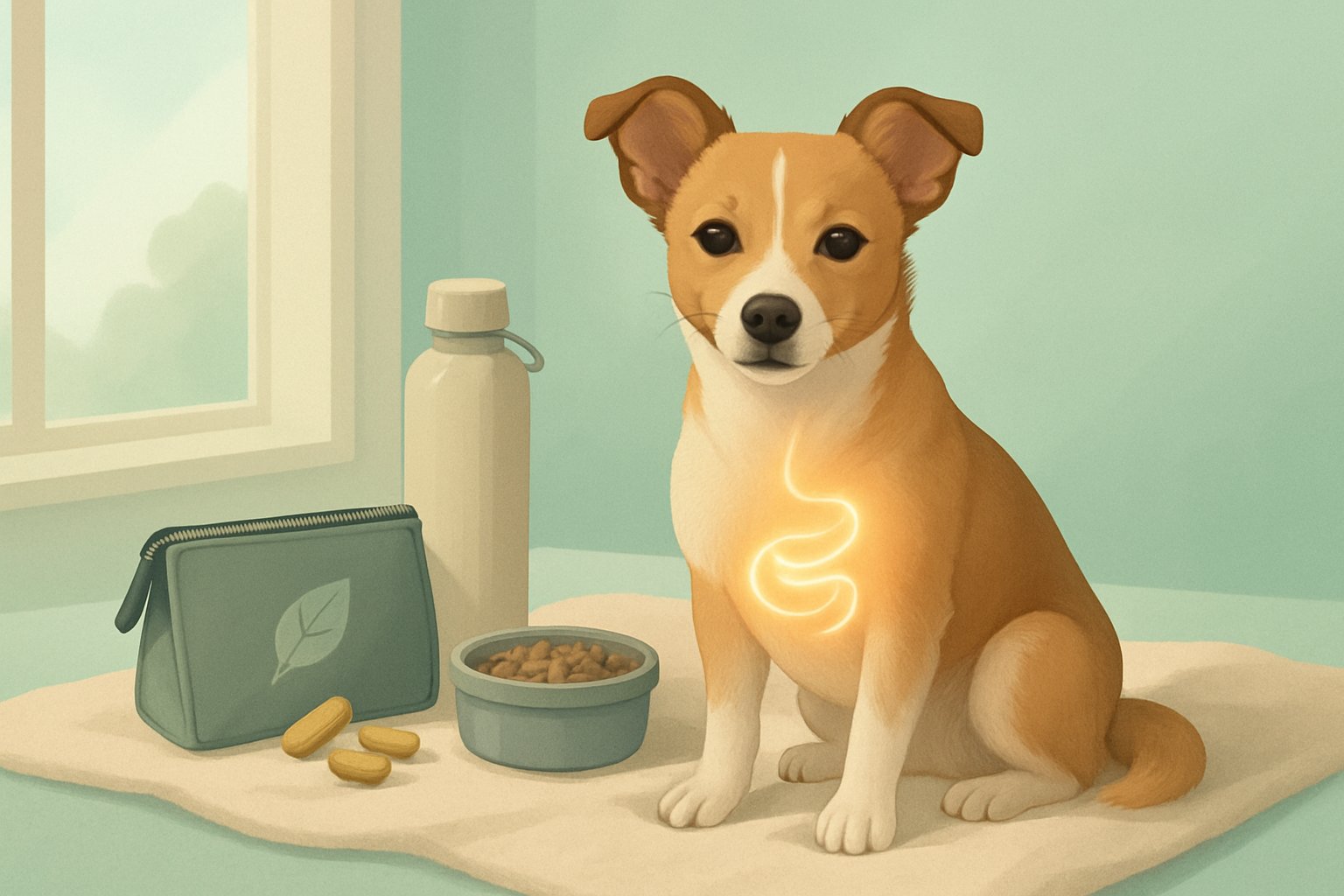
When small dog digestive problems pop up during walks or travel, pet owners need fast solutions. These portable remedies can turn a stressful situation into manageable relief within minutes.
Portable water is the most overlooked emergency tool. Dehydration makes digestive issues worse for small dogs, so carry a collapsible bowl and offer frequent small sips.
Plain rice cakes work as an instant bland food option. Break them into tiny pieces for small mouths to settle upset stomachs—no refrigeration or heating required.
Emergency Kit Essentials
| Item | Purpose | Why It Works |
|---|---|---|
| Pumpkin pouches | Fiber boost | Soothes stomach naturally |
| Probiotic paste | Gut balance | Restores healthy bacteria |
| Electrolyte powder | Hydration | Prevents dehydration fast |
Stress reduction helps more than most folks think. Small dogs can get digestive upset from anxiety, especially during outings.
Bringing along a familiar blanket or toy often calms their system a bit. Sometimes that’s all it takes.
Ginger snaps (plain, no sugar) offer natural nausea relief. Just a small piece can settle a queasy stomach, sometimes in as little as 15 minutes.
The 15-minute rule can really save the day: if symptoms don’t start to improve after a basic relief attempt, it’s time to pack up and head home. Small dogs can go downhill faster than bigger breeds, so it’s not worth the risk.
Bone broth packets give gentle nutrition when regular food won’t stay down. They’re lightweight and shelf-stable, which makes them perfect for emergencies.
Keep all relief items in a small pouch attached to the leash. That way, they’re always within reach when digestive trouble shows up out of nowhere.
Frequently Asked Questions
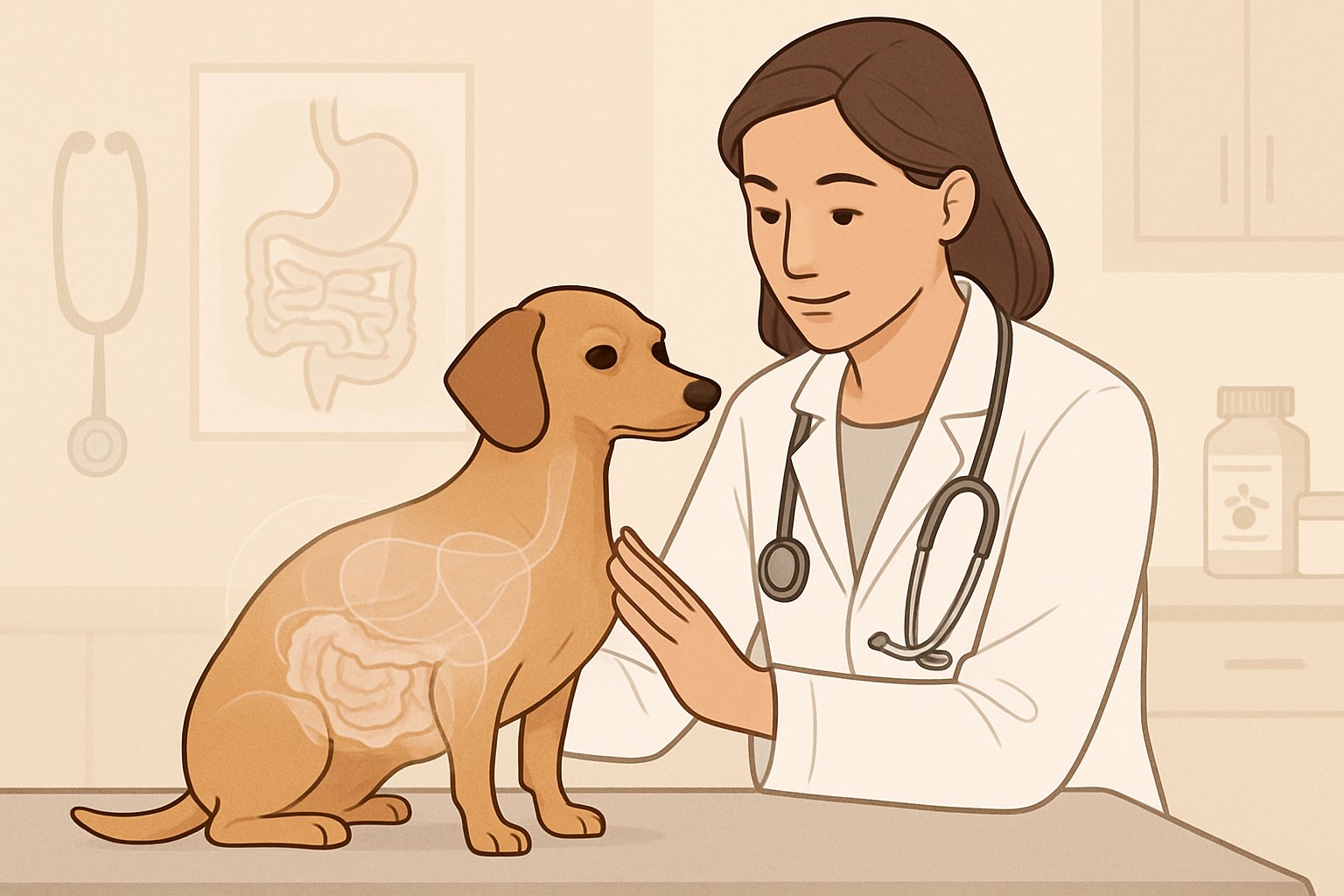
Small dog owners run into the same headaches with digestive health all the time. Here are the questions that pop up most often about keeping those tiny tummies happy—or at least less grumpy.
What can you whip up at home that’ll keep your tiny buddy’s tummy out of trouble?
Plain boiled chicken and white rice work wonders when a small dog’s stomach starts acting up. This bland combo gives their digestive system a break but still provides easy-to-digest protein and carbs.
Pumpkin puree (not pie filling!) is a natural fiber source. Just a teaspoon or two can help firm up loose stools in toy breeds.
Bone broth—no onions or garlic, please—adds hydration and nutrients. Always let it cool before serving so you don’t risk burning those sensitive tongues.
Steamed and mashed sweet potato brings gentle fiber and vitamins. Most small dogs only need a tablespoon or two mixed into their usual food.
How do you tell a top-notch tummy-friendly kibble for your pint-sized pooch from the rest?
Check the ingredient label for a single protein source listed first. That makes it easier to spot food triggers if digestive issues flare up.
Avoid foods with artificial colors, tons of preservatives, or by-products. Small dogs have sensitive systems and don’t need that extra junk.
Look for prebiotics like chicory root or actual probiotics on the label. These help support healthy gut bacteria in little digestive systems.
And kibble size? It matters. Tiny breeds need small pieces they can actually chew and digest—otherwise, it’s just asking for trouble.
Ever noticed how your little dog’s digestion takes a nosedive? Wondering what pet parents say actually works?
Lots of small dog owners swear by gradual diet transitions over a week or so. Mixing in new food slowly with the old stuff helps prevent stomach drama.
Feeding smaller, more frequent meals—think three or four a day—gives tiny stomachs a better shot at handling food. Two big meals just don’t cut it for most little guys.
Stress reduction matters a lot. Consistent routines and calm environments help more than you might expect, since small dogs pick up on household tension.
Regular exercise, even just short walks or indoor play, keeps things moving. It’s not just about burning energy—it helps with digestion too.
Stumbled upon some chatter about Royal Canin’s grub for the sensitive-stomached furballs — what’s the real scoop?
Royal Canin Digestive Care offers specialized nutrition for dogs with sensitive stomachs. Their formula uses prebiotics and highly digestible proteins.
The kibble size fits small mouths, making chewing easier and helping prevent gulping. That can make a real difference for tiny dogs prone to tummy trouble.
Plenty of vets recommend this brand for dogs recovering from digestive issues. The controlled ingredient list helps manage food sensitivities.
It’s pricier than regular kibble, though. Some dogs do great on it, while others show little improvement—results really depend on your individual pup.
Does swapping to Wellness CORE really get your mini-mutt’s gut in check, or is it just fancy branding?
Wellness CORE focuses on high-protein, grain-free formulas with limited ingredients. That can help dogs with grain sensitivities or allergies, at least in theory.
The brand includes probiotics, which support healthy gut bacteria. Lots of small dog owners report firmer stools and less gas after switching, but not everyone sees the same results.
Grain-free isn’t necessary for every dog, though. Some small breeds actually handle certain grains just fine and need the fiber.
The protein content might be too rich for some sensitive stomachs. Dogs with pancreatitis or other digestive issues might need lower-fat options instead—something to keep in mind.
Caught your four-legged friend giving you the ‘my tummy hurts’ puppy eyes after Purina ONE was discontinued — what’s the next best thing?
Purina Pro Plan offers a nutrition profile that’s pretty similar, with comparable ingredient quality. Switching to it usually goes smoother since it’s from the same company.
Hill’s Science Diet gives veterinarian-recommended nutrition, especially for sensitive stomachs. Their small breed formulas really focus on the unique needs of tiny dogs.
Blue Buffalo Life Protection comes in small breed options with natural ingredients. Plenty of pet parents say their pups handled the switch from Purina products just fine.
Try introducing the new food gradually over about a week. Start by mixing 25% new food with 75% Purina ONE, then bump up the ratio every few days.



Leave a Reply